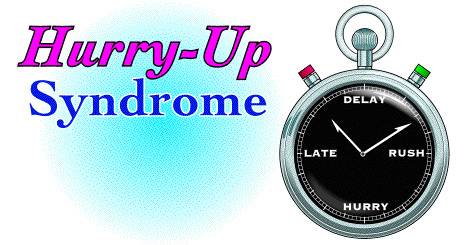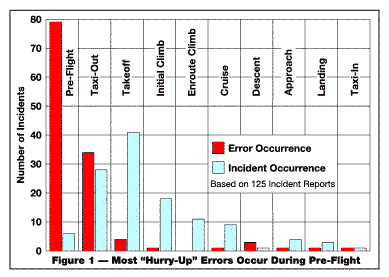![]()
Issue Number 5 : March 1993
|
|
Issue Number 5 : March 1993 |

by Jeanne McElhatton and Charles Drew
Aviation's worst disaster, the terrible KLM / Pan-Am accident at Tenerife [Endnote 1], was due in great part to schedule pressure problems experienced by both flight crews. The Air Line Pilots Association (ALPA) conducted an eighteen-month, three country investigation of this accident, with an emphasis on the human factors of flight crew performance [Endnote 2].
ALPA found that the KLM crew had strong concerns related to duty time, specifically that they would be able to return to Amsterdam that evening and remain within their duty time regulations. They also expressed concern about the weather and its potential to delay the impending takeoff -- the cockpit voice recorder indicates the KLM Captain said, "Hurry, or else it [the weather] will close again completely."
Pan Am's crew was equally concerned with potential weather delays. They were detained for more than an hour due to the KLM flight crew's decision to refuel -- the KLM aircraft and fuel trucks blocked the taxiway, thus preventing Pan Am's departure. These schedule-related problems set the stage for the catastrophe that followed.
This review of the Hurry-Up Syndrome is an adaptation of a research study in which we examined 125 ASRS incident records that involved time-related problems [Endnote 3]. We define Hurry-Up Syndrome as any situation where a pilot's human performance is degraded by a perceived or actual need to hurry or rush tasks or duties for any reason. These time-related pressures include the need of a company agent or ground personnel to open a gate for another aircraft, pressure from ATC to expedite taxi for takeoff or to meet a restriction in clearance time, the pressure to keep on schedule when delays have occurred due to maintenance or weather, or the inclination to hurry to avoid exceeding duty time regulations.
Each time-pressure incident had a point where the error occurred (Point of Error Occurrence), and another point, either immediately or further downstream, where the result(s) of the error(s) actually manifested themselves (Point of Incident Occurrence). Figure 1 shows the relationship between the error and incident occurrence for various flight phases.

A large majority of incidents (63 percent) had their origins in the pre-flight phase of operations. For example:
The taxi-out phase accounted for the second highest number of error occurrences, while all other operational phases combined amounted to less than 10 percent.
The errors made in pre-flight and taxi-out often manifested themselves later, during takeoff and departure. One reporter writes:
The next most common category for incident occurrence was the taxi-out phase with 22 percent of all reports:
Errors can be made by one individual, or they can be made by the flight crew as a collective unit. The majority (68 percent) of errors appeared to be collective. Collective error on the part of a three-person flight crew is well illustrated by the following report:
Human errors may be categorized as errors of commission or omission. Errors of commission are those in which pilots carried out some element of their required tasks incorrectly, or executed a task that was not required and which produced an unexpected and undesirable result. Errors of omission are those in which the pilot neglected to carry out some element of a required task.
Sixty percent of human hurry-up errors were errors of commission. In the following example, the flight crew erred in not adequately examining the airport surface chart:
In 38 percent of instances, pilots made errors of omission. In the following report, the flight crew neglected an important element of pre-flight preparation -- with annoying and unnecessary results:
In each incident report, one or more contributory or causative events promoted a Hurry-Up error on the part of one or more of the flight crew. As noted in Table 1, high workload was cited in 80 percent of all incidents, while problems involving physical or motivational states were next with 74 percent of incidents.
|
Table 1--Factors that Promoted Error |
|||
|---|---|---|---|
| Factors | Sub-Factors | Citations | Percent of Data Set |
|
High Workload |
|
100 | 80% |
|
Physical or Motivational States |
|
92 | 74% |
|
Delay (Source of Delay) |
|
69 | 55% |
|
Social Pressures |
|
48 | 39% |
|
Totals |
309 | 248% | |
| Note
1: This table is based on 309 citations from 125
reports Note 2: Each of these primary factor categories has two or more sub-categories, and multiple reponses are permitted. Thus, the total number of sub-category citations for any category will equal or exceed the number of citations noted for that category. Similarly, the number of citations will exceed the number of records in the data set. |
|||
FAA publication of on-time performance figures air carriers leads to "keep-to-the-schedule" pressures for flight crews and other company personnel. Similarly, conducting quick turn-arounds (typically for economic reasons), can also lead to schedule-pressures for pilots. In the following narrative, the reporter attributes his emergency to company schedule pressures:
ATC may contribute to the "hurry-up" mindset by requesting an expedited taxi or an intersection departure, by issuing a "clearance invalid if not off by...," or other time-sensitive requirements. (Of course, ATC personnel are similarly under pressure to maximize traffic flow.) In this example, the flight crew clearly felt pressured by ATC:
What types of incidents result from hurry-up errors? Deviations from Federal Aviation Regulations and/or ATC clearances are most common, while deviation from Company Policy or Procedure was next. As indicated in Table 2, the remainder of incident results comprise a fairly broad spectrum of problems.
|
Table 2--Incident Results |
||
| Factors | Citations | Percent |
|---|---|---|
|
Deviation from
ATC Clearance or FAR
|
60 | 48% |
|
Deviation from
Company Policy/Procedure
|
26 | 21% |
|
Runway Transgressions
|
21 | 17% |
|
Miscellaneous
Other
|
20 | 16% |
|
Aircraft Equipment
Problem
|
15 | 12% |
|
Altitude Deviation
|
14 | 11% |
|
Fuel Errors
|
13 | 10% |
|
Dispatch and
Paperwork Errors
|
12 | 10% |
|
Landing or Takeoff
Below Minimums
|
11 | 9% |
|
Track or Heading
Deviation
|
11 | 9% |
|
Totals
|
203 | 163% |
| Note
1: This table is based on 203 citations from 125
reports. Note 2: Multiple responses are premitted for each category, thus there can be more citations that the total number of reports. |
||
Hurry-Up errors appear most likely to occur in high workload operational phases, specifically in pre-flight and taxi-out. External distraction and schedule pressure are significant predisposing conditions -- but why here and not in other flight phases?
Most flight phases of air carrier and commuter operations employ well designed standard procedures that are linear in nature -- a given required task follows another required task. For example, in the takeoff phase the application of power is followed by a check of engine performance or power, which in turn may be followed by a performance check at 80 knots, and V1, VR, V2, gear and flap retraction respectively, depending on the particular aircraft and operator.
In contrast, duties in the pre-flight phase may be non-linear, i.e. there may be no logical or prescribed sequence. A pilot may need to deal with flight planning, weather information and changes, fuel loading, dispatch manifests and release, last-minute maintenance or MEL items, duty time requirements, or aircraft deicing at pretty much the same time. There may be no standard operating procedure (SOP) for assigning sequence or priority to these tasks, nor does one task necessarily or obviously require that another task be previously and correctly completed -- thus it may be easier to make an undetected error.
On the other hand, tasks or duties in the taxi-out phase should be linear, yet this was the second most common flight phase for error occurrence. It is possible that many flight crews have not cleanly transitioned from one flight phase to the next, and may be trying to complete pre-flight duties during taxi-out. Another thought is that pilot's may experience difficulty in the transition from the non-linearity of pre-flight activities to the linear duties of the taxi-out phase.
Returning to the issue of pre-flight activities, it may be appropriate to examine cockpit or crew coordination. In an in-flight phase where the flight crew is seated together with unrestricted capability for interpersonal communication, the practice of Crew Resource Management (CRM) is facilitated by physical proximity and access. In the pre-flight phase of operation, interpersonal communication may be degraded by physical separation of flight crew members, and by distraction from numerous external sources.
It is suggested that companies and flight personnel consider providing greater structure to pre-flight activities in order to reduce the frequency of time-related errors. Similarly, when distraction and schedule pressure are seen to occur in this flight phase, a reasonable response is to slow down and carry out tasks in as linear a fashion as practical. Where time-related pressure is encountered from external sources, pilots may find it a good strategy to calmly explain the nature, probability, and typical results of hurry-up errors to those who "apply the pressure."
| Reproduction and redistribution of ASRS Directline articles is not only permitted--it is encouraged. We ask that you give attibution to ASRS Directline, to the Aviation Safety Reporting System (ASRS), and of course, to the authors of each article. |